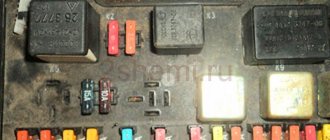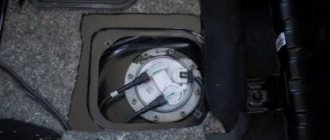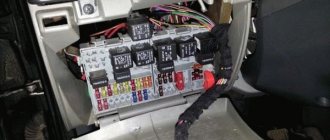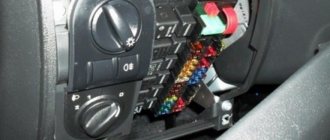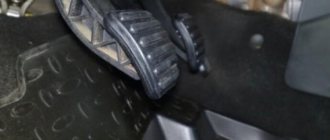Hi all! I am dealing with a typical and common problem: the Niva Chevrolet fuel pump does not work. Yesterday I got into the car, started it - it started, but immediately stalled. The first thought that came to mind was that the fuel pump was broken. When you start the engine, you can hear the pump humming, after which the relay is activated and it stops pumping fuel. I left the car, the next day I tried to start it - the pump did not hum and the pump did not start. What to do?
You correctly noted that when you turn the ignition key, the relay is activated and the fuel pump starts working, supplying fuel to the cylinders through the lines. If you can't hear the pump whirring, it's most likely broken. To find out if this is actually the case, you need to do a few simple steps. Let's talk about everything in order.
Chevrolet Niva fuel pump does not work: what to check?
Once upon a time I also wondered what to do and where to look first if the fuel pump does not work. To begin with, I recommend that you remove the negative terminal of the battery in order to “reset” the brains of the on-board computer. If after this the pump starts working, great, the problem is solved. But this doesn't happen every time.
So, the order of further actions is as follows:
- We open the hood, find the fuel rail, there is a cap on the side, under which there is a spool. Find the valve there, click on it. Is there a small trickle of fuel? If yes, great!
- No fuel flow? Try turning the ignition key several times, and then press the valve again
- If nothing works, then most likely there is no pressure in the system, therefore, it is the fuel pump that has broken down
Don't forget to check the fuse. It may burn out, then the pump simply will not be able to work. We move the front passenger seat and find the fuse under the dashboard. We check it, if it works, we move on. If it burns out, we replace it with a new copy.
Poor quality gasoline and pump
This is the kind of gasoline we sell!
But at domestic gas stations today it is not always possible to fill the car with good gasoline. In this regard, the fuel pump can fail at any time. In this case, the car will either constantly stall, or it will simply be impossible to start. In some situations, a malfunction of the unit will not be able to be shown by the BC. In this case, the problem should be looked for in mechanics.
Checking the fuel pump relay Niva Chevrolet
Sometimes the fuse is not firmly in its seat, although it is intact and serviceable, but in this case it will not work. Check whether it lies tightly; if necessary, press the “legs” of the fuse, only carefully, this will be more reliable and effective. Then we move on to the relay. If you hear the relay clicking when you start the engine, it means it is more likely to be working properly. Otherwise, the mechanism must be checked and changed.
A 12 V and 30 A relay is suitable - article number 752.3777-121. But, before changing the relay, check the wiring. Maybe there was a break somewhere or the contact was oxidized? Under the rear seat there is a small hatch on the right side, open it, remove the connector, check the voltage with a multimeter - it should be 12 V. If the readings vary greatly, look for the place where the circuit break occurred. This is how we smoothly and evenly find the problem area, and then fix the breakdown. Good luck.
A fairly common option: “It’s getting cold outside. I got into the car, started it, and the car immediately stalled!” My first thought was “the fuel pump is broken.” The starter spins briskly, but doesn't grab a beat.
0) When the car is working properly, when you turn the ignition key, you hear a click from the fuel pump relay (under the glove compartment, at the passenger’s feet), after which the fuel pump hums for 4-6 seconds (increases pressure), after which the relay clicks again. Also, the relay and pump operation can be heard while the starter is running. (But due to the operation of the starter itself, it is very quiet).
In my case, the relay was audible, but the pump was silent.
But you should keep in mind that clicks and the pump will only be heard the first 2 turns of the key. After this, Boshev’s “brains” block the work of pressure, it is believed that there is pressure in the system.
You can reset the negative terminal from the battery for a few minutes (reset the “brains”). After this, the pump will turn on again.
Make sure there is gasoline in the gas tank. (although the relay will click without it, the pump will be audible even without it).
What to check, where to crawl. 1) We get under the hood. Fuel rail (where the molds are) At the end of the ramp (from the windshield side) there is a cap. Under the cap there is a spool (valve) that, when pressed, gasoline should flow from the ramp in a good stream. After several attempts to start the key, there should be a trickle. You can check with two people (one turns the ignition key, the second checks the pressure in the rail). If there is pressure, everything is fine with the fuel pump. That's not the reason.
If there is no pressure, then the problem is probably with the fuel pump.
2) Check the fuel pump fuse. It is located under the glove compartment. At the feet of the front passenger. We move the seat to the rearmost position and crawl there:
3) Check the fuel pump relay. Indirectly, a faulty fuse may be indicated by the absence of a characteristic “click”. If it “clicks”, then everything is fine with it. It is located in the same place as the fuse.
4) there is a hatch under the rear right seat. Let's open it.
5) Remove the fuel pump. It is advisable to have less than 1/3 of a tank of gasoline. I recommend tying the hoses and electrical wire so that after disconnecting from the fuel pump they do not fall into the niche. Unscrew 12 M10 nuts. We get the fuel pump.
6) Diagnostics of the fuel pump. Dry the fuel pump. Provide 12 V in home laboratory conditions. Check all terminals. Sometimes it burns noticeably:
Relay and fuse diagram for Lada Niva (Chevrolet)
In the event of a car breakdown related to electrical equipment, first of all, check the integrity of the fuses and relays. If a fuse is blown, you must first determine the cause of its blown before replacing it. Details about the mounting block (popularly “black box”) of the Lada Niva (Chevrolet) are described in the operating manual, but the most complete information is contained in the repair manual for the Chevrolet Niva 1.7, which was developed by ITC AUTOSPHERE LLC at the request of JSC "GM AVTOVAZ".
Basic principles of operation of the fuel pump relay in Niva Chevrolet
Problems with electronics in cars are quite common, and sometimes it is difficult to understand what exactly is causing the problem. One of the problems in which the system that supplies the engine with fuel fails is a common breakdown associated with the fuel pump relay; the Chevrolet Niva is a car where this malfunction also occurs quite often. This part is responsible for the functions of the electronics, so it is difficult for drivers to calculate this malfunction, since everything connected with it is always a dark forest, so it is much easier to go through the entire engine than to get into the brains of the car. Let's take a closer look at what functions this relay performs and where it is located.
What is a relay?
It is an electromagnetic switch used in switching when input current surges occur in the entire electrical circuit. It acts as an amplifier since the supplied current is low, and to start the fuel pump, a current with a higher value is required.
What does a relay consist of?
They are different, and usually perform the same functions. The structure of this element can be seen if it is removed from the block, and it consists of a contact group. Inside there is a coil, which has a certain number of turns, as well as an armature and a return spring.
Operating principle of the element
The fuel pump relay is most often used in engines with an injector. Chevrolet Niva cars have a 12V electric fuel pump. Its electrical circuit includes such elements as:
- Fuse
- The power cord itself
- A sensor that shows the fuel level in the tank
- Relay
When the key is turned, power is automatically supplied to the relay, that is, the fuel pump is turned on, and when the ignition key is turned, sounds are heard, which indicates that the element is working normally. It is located on the glove compartment side, under it there is part of the electronics, and the second part is located on the driver’s side. There are four relays underneath it, the device responsible for operating and turning on the fuel pump is located at number three, and the fuse responsible for protecting electrical devices and circuits is located next to it.
It happens that when you start a car, the pump does not work, but the fuse is good, this may indicate that the pump itself has failed, you can understand this by measuring the voltage with a voltmeter, if the voltage is 12V, then this will indicate that the pump is broken , and you need to buy a new one.
If the relay fails, can I repair it myself? If the reason is clear why the fuel pump is not working, then it can be repaired simply by replacing it with a new working one. Of course, a specialist can sort it out, but it’s better if you buy a new one. The price of a new relay for a Chevrolet Niva is approximately two hundred to four hundred rubles, the same price will be for repairs, so it’s up to you to decide what type of replacement you choose. If you know where this device is located and you are aware of how it works, you can try to fix the problem associated with the inoperability yourself.
Electrical wiring components
The standard Niva Chevrolet wiring diagram is divided into several sections for better maintainability and ease of maintenance.
- Front part - a set of cables connects all equipment located in the engine compartment of the car.
- The interior part - the unit is additionally divided into independent zones, which allows you to power different groups of equipment without the risk of damaging or overloading the main elements.
- Instrument panel compartment - a bundle of cables combines the lines from all gauges, sensors and indicators.
- The stern assembly - the bundle is responsible for voltage and control of equipment located on the rear side of the vehicle.
Where is the Niva Chevrolet fuel pump relay located?
One of the most common cases, most disliked by car owners, is the situation when the car does not start at the most inopportune moment. The cause may be a breakdown of the fuel pump, however, in order to try to fully implement a set of diagnostic measures, quickly find and fix the malfunction, it is advisable for the car owner to know where the Niva Chevrolet fuel pump relay is located.
The fuel pump relay is a very important part; some experts call it one of the key parts in the fuel system of a car. There is a great deal of truth in this statement, because this element, in essence, is a kind of key, a switching device, without which your engine simply will not start.
Like any relay, it works on the principle of closing-opening an electrical circuit under the influence of an electromagnetic field, and turns on when voltage is applied to the contacts. In addition, it serves to enhance the impulse supplied to the fuel supply system.
Finding a Niva Chevrolet fuel pump relay is not so difficult. It is located in the relay box located under the glove compartment on the right side. Opening the cover, you can see four switching devices. One of them, the third from the left, is the fuel pump relay, which is located near the 15-amp fuse, which is responsible for the safety of the entire electrical circuit of the system. This arrangement was made for the convenience of users so that they can have unhindered access to the device.
The design of the fuel pump relay is fundamentally no different from many similar devices. It consists of a coil of copper wire, contacts, a return spring and an armature. The relay is powered by a voltage of 12 volts, and switching occurs after the key is turned in the ignition switch. The pulse activates the contacts, they close, and power is supplied to the fuel pump. It is at this moment that we usually begin to hear a characteristic buzzing sound, indicating that the fuel supply system has started and is working normally, which means there will definitely be no problems with this.
Wiring diagram of the VAZ Niva, the part responsible for powering the head optics
- 1 – main lighting device;
- 2 – fuse box;
- 3 – headlight switching regulator;
- 4 – part of turning off the ignition;
- 5 – headlight switches;
- 6 – designation in the instrument cluster of the area responsible for turning on the high beam;
- K4/5 – protective relays for turning on the high- and low-range modes of the head optics;
- A – terminal pins going to the circuit’s power source.
Relay for controlling the fuel supply system to the Chevrolet Niva engine
There are often breakdowns in cars related to electronics. And sometimes it is very difficult to detect the cause of a malfunction. A common cause of breakdowns on the Chevrolet Niva is breakdowns with the fuel pump. The main problems of failure of the engine fuel supply system are: breakdown of the fuel pump itself, clogged filter, breakage of supply wires, damage to tubes, failure of fuses or breakdown of the fuel pump control relay. The last reason, although not common, always remains a mystery to most drivers. This part performs electronic functions, and electronics in a car are a dark forest for the average driver. “It’s much easier to rebuild an engine than to delve into the brains of a car,” many drivers would say. In order to clarify the picture of the need for a relay in a Chevrolet Niva, let’s take a closer look at what it consists of and what functions it performs.
What is a relay
A relay is called an electromagnetic switch, which is designed for switching during abrupt changes in the input value (current, voltage) in electrical circuits. In simple terms, it is a device that turns on when a voltage signal is applied to it, and turns off when the voltage disappears. The current that switches the device is very low, and to start the fuel pump a large current is required. Therefore, it is also called a kind of amplifier.
There are different numbers of relays, but almost all of them perform similar functions. This device consists of a contact group, which we can see by removing it from the block. Inside it there is a coil with a certain number of turns of copper wire, a return spring and an armature. All this is assembled in a certain sequence and located on the board. A photo of the contact group and the shape of the relay can be seen below, or you can enter it in a search engine and see all the types and types. We are interested in the Chevrolet Niva fuel pump relay, which looks like this.
A universal scanner for self-diagnosis of any car.
To reduce fuel consumption on a Shnivy, all you need to do is.
Relay operating principle. The fuel pump relay is used only in engines with injection type. Carburetor engines use a mechanical fuel pump. The Niva (injection) car uses a 12V electric fuel pump. The electrical circuit of its operation includes power wires, a fuse, a relay, as well as fuel reading sensors in the tank. Thus, when you turn the car key, power is automatically supplied to the relay. It, in turn, operates instantly and closes the contacts that power the pump. This is how the fuel pump turns on briefly, as a result of which, when we sit behind the wheel and turn the key, we hear its buzzing, indicating its operation.
Location in Niva
On the right side under the glove compartment there is a cover, and under it there is part of the electronics of the Niva car, the second part is under the dashboard on the driver’s side. Under this cover you can see the location of four relays. The device that is responsible for turning on the fuel pump and its operation is located under the third number. Next to it is a 15A fuse, which is designed to protect the circuit and electrical components of the fuel pump.
location of the relay box in the car
Functionality check
To determine whether a given device is working properly, you can use two methods:
- Remove the fuel pump relay, the location of which is indicated above, and put in its place, exactly the same. After installation, check the functionality of the fuse. Having temporarily replaced the relays, you can try to start the engine; if, when you turn the key, fuel pumping begins, then the cause of the breakdown has been eliminated.
- The first method involves having a spare relay. If it is missing, there is no need to rush to the car market and spend money if you are not completely sure that it is faulty. You can make a jumper from a piece of wire. You can use a thin wire, since the current in the control circuit of the device is small. Use this jumper to short-circuit two contacts on the block numbered 30 and 87. Their location can be determined from the picture on the relay. While closing these contacts, you must turn on the ignition or do this at the end. If the pump works in this case, the switching device itself must now be replaced. It is prohibited to use the jumper on a permanent basis; it is used solely for fault detection.
Instrument panel pinout
Here is a description of the terminals and terminals of standard instrument panel wiring:
- 1 – diagnostic output, located on the underside of the board under the steering wheel;
- 2 – plug connector for connecting the ECM;
- 3/4 – standard modules for connecting the front connection of the cores responsible for the engine control systems;
- 5/7 – left and right steering column switches;
- 6 – ignition switch device connector;
- 8 – instrument panel combination;
- 9 – output for powering the connector of the contact group of the interior ventilation and heating system;
- 10/11 – lighting plugs for the above equipment;
- 12 – button switch of the alarm device;
- 13 – mounting box for fuse insertion;
- 14/15 – the lamp itself and the button to turn off the lighting of the glove compartment;
- 16 – contact pin for turning off the brake lights;
- 17 – switch of the standard sound warning module (horn);
- 18 – automatic protection of fog lights of head optics;
- 19 – automatic window lifters;
- 20 – protective relay for sound signal;
- 21 – safety module for the seat heating system;
- 22 – starter control relay;
- 23 – switch for the external lighting system;
- 24 – contact group for connecting the stove fan;
- 25 – built-in switch for turning on the heated windshield;
- 26 – device for turning off the front fog lights;
- 27 – switch for stern lights, fog lighting group;
- 28 – air conditioner setting button;
- 29 – position regulator of heating manipulators;
- 30 – cigarette lighter pin;
- 31 – buttons for adjusting the direction of the light flux of the head optics;
- 32 – adjust the brightness of the instrument panel illumination;
- 33 – auxiliary resistor mechanism of the heating fan;
- 34 – standard immobilizer module;
- 35/36 – standard-type onboard acoustic module terminals;
- 37/38 – terminal connectors for connecting the rear harness of the on-board circuit.
Where is the fuel pump fuse on a Niva Chevrolet?
As a rule, every modern car has a fuse that protects the entire electrical circuit, and if any overload or short circuit occurs, it breaks it. And in cars in which an injector is installed, this element is very important since in them the electrics are responsible for almost all the processes occurring in it. The Chevrolet Niva SUV is no exception; it also contains electrical circuits that are protected by fuses. One of the important ones is the circuit responsible for powering the fuel pump. In this article, we will look in more detail at where the fuel pump fuse is located, a Niva Chevrolet car in which problems periodically arise with it.
- 1 Where is the fuse located?
- 2 Basic parameters
Where is the fuse located?
Designers usually try to place them in one place, namely in the mounting block, as this is more convenient. Niva engineers also placed the relay and these elements that protect the electrics and the entire control system in one place, under the glove compartment, which are secured by a controller bracket.
Main settings
This device, which protects the operation of the fuel pump, is located under the glove compartment in the mounting block and with a rating of 15 A, near the fifty-amp relay that protects the power circuit, and the second relay on the left side is responsible for starting the fuel pump. You can find it in the following way
- Disconnect the terminals from the battery
- We take a Phillips screwdriver and unscrew the self-tapping screw located on the right that secures the glove compartment.
- On the left side there are two screws securing the plastic, on the center console itself
- After this, in the opened glove compartment in the lower part there are a couple more screws that should be unscrewed
- Next, at the top fastening and in the middle, unscrew a few more screws
- Having unscrewed all the elements that secure the glove compartment, remove it, tilting it and disconnecting the wires that power the backlight.
- Remove the protective cover that protects the mounting block with the controller
- Take a ten key and unscrew the screw that holds the protective cover.
Having completed all the above steps, you can get to the mounting block, in which the fifteen-amp fuse responsible for the operation of the fuel pump is located. But you should know that if the device burns out, do not rush to change it, but find the reason why this happened, a short circuit or any overload is to blame, the reason can be understood by ringing the entire circuit, and only after the reason has been identified can a replacement be made new.
Methods for troubleshooting the electrical circuit of the fuel pump
A faulty relay or fuse is replaced with a new one, but first the cause of its failure must be eliminated . If there is a break or short circuit in the circuit, then this part of the wiring is replaced entirely. Poor contact in the connectors can be corrected by crimping or soldering the wires. The cost of a new relay in a store averages 200-400 rubles. At the same time, expensive does not always mean high quality. First of all, pay attention to the appearance of the relay and workmanship, as well as reviews from sellers.
Advice! Temporarily, to continue driving, you can use the removed relay from any secondary circuit.
The fuse can only be replaced with the same one with a nominal value of 15A . Chevrolet Niva is equipped with modern blade fuses that never lose contact due to vibrations and last quite a long time.





